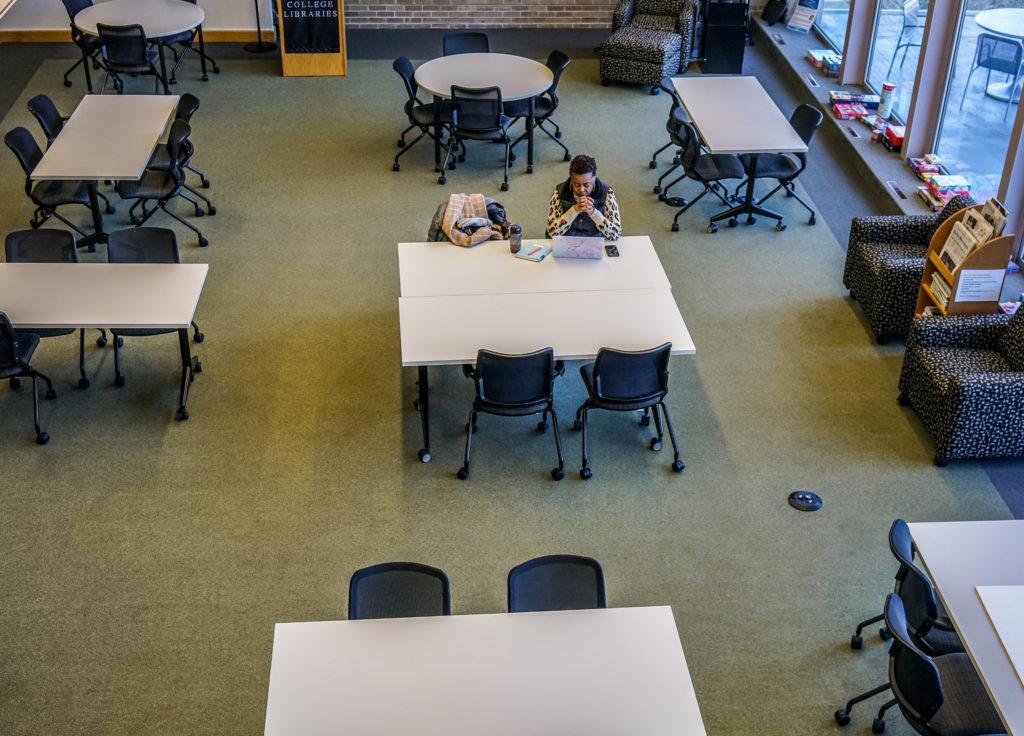
By Mira Berkson
berksonm@grinnell.edu
Have the shiny glass walls of the HSSC not only encircled the ARH, but also engulfed our friends? Usage figures provided by Burling Library show that there were around 5,000 less patrons in Burling during the fall semester of 2019 compared to the fall of 2018. Perhaps students are obsessed with the new egg chairs of the HSSC, turning away from wooden chairs and yellowed historical texts.
“I feel like last year, it was definitely more people and harder to get tables to yourself, and now we have so many open tables,” said Batyah Selis ’21, interviewed in Burling on a Tuesday evening.
However, the apparent droppingoff is complicated when considered in the context of recent events at Grinnell. In 2015, before HSSC construction began, fall semester attendance at Burling hovered around the same 16- 17,000 mark as it did this academic year.
“Usage looks very similar to numbers pre-HSSC,” said Mark Christel, department chair of the library. He said that while the numbers may fluctuate, the profile of a Burling-studier has remained constant throughout the years: “I think people that tended to like library spaces and want that academic feel and want to really hunker down and do serious work still tend to come here.”
Hyeyun Jung ’23 is a technology research circulation consultant at Burling, and feels that Burling is still a relatively busy place, especially during peak hours, but also believes that the space is generally underappreciated.
For Dean Khazanov ’22, his go-to spot is the Apple computer lounge in the HSSC. “Each room has a computer and each room is able to hook up to the projector and everything, so, it really has everything … there would be no reason for me to come to the library unless I needed a book.”
Similarly, Burling-dweller Sam Xu ’20 said that the HSSC and Burling work for different types of studying.
“I will only study in HSSC if there is an awkward amount of time, like a half hour or 45 minutes, if I want to study for, like, more than an hour, I will come to Burling,” he said.
Selis agrees. “I think because the fact that it is a library, it has that aura of productivity, so even if I’m not being productive, I know someone else is,” she said.
Caroline Loftus ’20 likes the small scale and relative quiet of Burling.
They said, “I think that the HSSC, especially the atrium, is a very open space that can get really loud. I don’t like studying there ‘cause it can really feel like a panopticon there, like I’m just being watched and watching other people all the time.”
Christel attributes these spatial dynamics to the expectations of students in 1959, when Burling was constructed. “The architects that built Burling wanted to design it as one big room. So, they have it all open because, the model was, in the 1950s, you came in and you were quiet, right?”
Burling is the smallest library of Grinnell’s ‘Peer 16 institutions’ main libraries, both in terms of square footage and number of seats. Burling seats 436 people and takes up 56,400 square feet. In comparison, the average amount of seats for a Peer 16 library is 849, while the average square footage is 122,060.
Christel added that as the type of work students do gets “a little noisier and more collaborative” due to inquiry-based learning and team-based projects, Burling has struggled to keep up with the changes in pedagogy. Many of the resources featured in Peer 16 libraries such as a data science lab or makerspaces are located in other places on Grinnell’s campus, not the library.
Khazanov mentioned the presence of the Data and Social Inquiry Lab (DASIL) as a component of his preference for studying in the HSSC: “Personally, HSSC has everything that I need … all the technology resources ‘cause there’s DASIL and I use DASIL a lot.”
Burling has a variety of renovations planned for the future, including a Digital Humanities Center and new seating. Yet, Christell claims Burling doesn’t need to change to be useful because it serves a specific niche of students on campus very well.
“When we talk about the sense of belonging at Grinnell, I think libraries are a piece that contributes to that, and we could play a bigger role, I think if we had the right types of spaces and things, but I think coming to a space where everybody’s committed to serious reflection and study, it brings people together,” he said.





















































